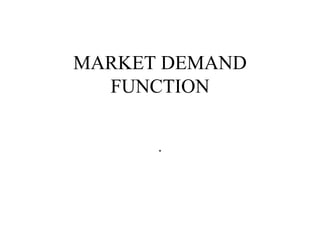
Market Demand function
- 3. Demand in Mathematical Terms .
- 4. Review We know that how much of a product consumers want depends on 1) the price of the product, 2) the consumer desire or taste and preference for the product, 3) the level of prices of other goods, 4) the level of consumer income, 5) the number of consumers in the market. In a general mathematical sense we may summarize this with the following Qx = f(Px, Py, T, M, N) .
- 5. general math form On the previous screen Qx = the amount people want of good x, f means is a function, note the parentheses here is not a multiplication sign, Px = the price of good x, Py = the price of good y, T = a measure of consumer taste, M = consumer income, N = a measure of the number of consumers in the market. So, the amount people want depends on or is a function of these influences listed in parentheses.
- 6. Linear demand A linear demand curve might be of the form Qx = a0 + axPx + ayPy + aMM. Note the a’s with subscripts just means we have a number here. Many books use the greek letter alpha here. The a’s may be positive or negative. As an example say we have Qx = 1000 - 3Px + 4Py - .01M
- 7. Linear demand Now if Px = 1, Py = 1 and M = 50,000 Qx = 1000 – 3(1) + 4(1) - .01(50,000) = 1000 – 3 + 4 – 500 = 501. Once we have the from and coefficient values of the relationship between the variables we can make “predictions” about how much people want based on the value of prices and income and other variables.
- 8. Market demand The market demand is the demand from each individual added together. Say in a market we have two buyers. The demand from each is Q = 10 – 1P, and Q = 20 – 2P, respectively. (you will notice I only have the price term listed. All the other influences are captured in the Q intercept.) Now, if the price is $1 per unit, the demand is 9 and 18, respectively. So the market demand is 27. Here is how we add the demand functions of each individual to get the market demand : (next screen)
- 9. Market demand Q = 10 – 1P Q = 20 – 2P Q = 30 – 3P Notice on the left side on the addition I did not put 2Q. The reason is due to the notation used. The Q for each person is personal, but I just used Q. You can see at a price of 1 the Q is not the same for each person. (We just did this last screen.) Notice the market demand curve Q = 30 – 3P does add up the demand from each individual at a given price. If P = 1 we have a market demand of 27 (= 9 + 18).
- 10. Inverse Demand curve We just saw a market demand curve of Q = 30 – 3P. I could rewrite this as P = 30/3 – (1/3)Q. When written with P on the left we call the demand curve the inverse demand curve. We write it this way because in a graph we typically have the price on the vertical axis and so the equation follows that convention. In general we write P = A – BQ. (Note: do not add individual demand curves when written in inverse form – you do not get what you want.)
- 11. Nonlinear demand Demand may not be a linear function. A popular nonlinear form takes the form Qx = cPx BxPy ByMBMHBH. An example would be Qx = 10Px -1.2Py 3M.5H.3 . An interesting thing about this form is if you take the natural log (sometimes written Ln)of each side you get log Qx = 10 – 1.2 log Px + 3 log Py + .5 log M + .3 log H . This nonlinear demand is said to be linear in logs.
- 12. Natural log On the previous screen you see we have the amount demanded in the form of a natural log. To get the value in the terms you and I are used to you would take the value given and make it the exponent of the term e. Microsoft excel has the the function ln to put values into natural log form. To get out of natural log form use the exp function.
